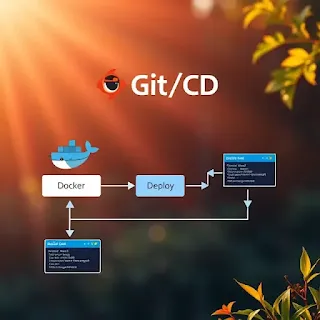Creating a Reusable Docker Build Template in GitLab CI/CD
In a modern CI/CD pipeline, building and pushing Docker
images is a common requirement. However, many projects use the same steps for
Docker image builds, so it makes sense to abstract these steps into reusable
templates. This article will walk you through how to create and use a reusable
Docker build template in GitLab CI/CD, so you can reuse the same
configurations across multiple projects.
Why Use Reusable Docker Build Templates?
When you define the Docker build process in every project
separately, you might find yourself repeating the same configurations over and
over. Not only does this increase the chance of mistakes, but it also makes
your CI/CD pipeline harder to maintain. By using reusable templates, you can:
- Centralize
common configurations: Have all your Docker build steps defined in one
place.
- Reduce
duplication: Reuse the same configurations across multiple projects.
- Improve
maintainability: When changes are needed, they can be made in one
place, automatically applying to all projects using the template.
- Enhance
consistency: Every project will follow the same Docker build process,
ensuring uniformity across environments.
How to Create a Reusable Docker Build Template
The basic idea of a reusable template is to define a set of
steps (like building and pushing Docker images) in a template file, which can
then be used in multiple projects. Here’s how you can do this.
1. Create the Reusable Docker Build Template
The first step is to create the reusable Docker build
template itself. This template will contain the common build logic, including
Docker login, building the image, and pushing it to a container registry.
You should define this in a .yml file, which will be
referenced later by the projects that need it.
Example Reusable Docker Build Template (reusable-docker-build.yml):
# Reusable Docker Build Template
stages:
- build
.docker-build-template:
stage: build
image: docker:latest # Using the official Docker image for
building
services:
- docker:dind # Docker-in-Docker service for building
images
variables:
DOCKER_HOST: tcp://docker:2375 # Enabling Docker access via TCP
DOCKER_DRIVER: overlay2 # The Docker storage driver to use
script:
# Step 1: Docker
login to GitLab Container Registry
- echo "Logging
in to GitLab Container Registry"
- echo $CI_REGISTRY_PASSWORD
| docker login -u $CI_REGISTRY_USER $CI_REGISTRY --password-stdin
# Step 2: Build the
Docker image
- echo "Building
the Docker image"
- docker build -t $IMAGE_NAME:$TAG
.
# Step 3: Push the
Docker image to the registry
- echo "Pushing
the Docker image"
- docker push $IMAGE_NAME:$TAG
rules:
# Trigger this job
for specific branches or tags
- if: $CI_COMMIT_BRANCH
== "main"
- if: $CI_COMMIT_TAG
This template defines:
- Stages:
The pipeline’s stages, with build as the only stage here.
- Image:
Specifies the Docker image used for the job.
- Services:
Enables Docker-in-Docker (docker:dind), allowing Docker commands to
run inside the CI/CD job.
- Variables:
Configures environment variables like DOCKER_HOST for Docker’s
communication channel.
- Script:
The sequence of commands to build and push the Docker image.
- Rules:
Defines when this template should run (e.g., on the main branch or
tags).
2. Include the Reusable Template in Your GitLab Project
Now that we have the template file (reusable-docker-build.yml),
we can include it in other GitLab projects where you want to use the same
Docker build logic.
Example Project .gitlab-ci.yml:
# Include the reusable CI/CD component for Docker build
include:
- project: 'tcs_cmi/marim/docker-components' # The shared repository with the reusable
template
file: '/template/reusable-docker-build.yml' # Path to the reusable Docker build template
# Define a visible job to build and push the Docker image
build_image:
extends: .docker-build-template # This job will inherit configurations from
the template
variables:
IMAGE_NAME: $CI_REGISTRY_IMAGE # Unique image name based on project
repository
TAG: $CI_COMMIT_REF_NAME # Use the current Git reference (branch or
tag) as the image tag
In the above .gitlab-ci.yml file:
- include:
Specifies the path to the reusable template. This file is fetched from
another repository (tcs_cmi/marim/docker-components) that holds the
reusable-docker-build.yml template.
- extends:
Inherits all configurations from the template (.docker-build-template),
so the job will automatically use the same steps defined in the reusable
template.
- Variables:
You can customize the job’s variables (e.g., IMAGE_NAME and TAG)
specific to your project, overriding default values in the template.
3. Customizing the Docker Build Job
The great thing about using a reusable Docker build template
is that you can customize specific aspects of the build process without having
to change the template itself. The key customizations can be done in the variables
section of the project’s .gitlab-ci.yml file.
Here are a few things you might want to customize for your
project:
- IMAGE_NAME:
You can use $CI_REGISTRY_IMAGE to automatically generate the image
name from the GitLab registry or set it manually.
- TAG:
Use $CI_COMMIT_REF_NAME to automatically set the tag based on the
branch or tag being pushed.
- Other
Variables: You can add custom environment variables to control the
build process.
Benefits of Using Reusable Docker Build Templates
- Efficiency:
Reusable templates reduce the need to define the same Docker build steps
across multiple projects, saving you time and effort.
- Consistency:
Ensures that all projects follow the same process for building and pushing
Docker images.
- Maintainability:
When you need to change the Docker build process (e.g., update the base
image), you can do it in the template, and all projects using it will
automatically be updated.
- Scalability:
As your organization grows and you manage more Docker images and CI/CD
pipelines, templates allow you to scale easily.
Conclusion
By creating and using a reusable Docker build template in
GitLab CI/CD, you can streamline your pipeline configurations, ensure
consistency across projects, and simplify maintenance. Instead of duplicating
the same Docker build steps across multiple .gitlab-ci.yml files, you can
define a single template and reuse it as needed. This approach will save you
time, reduce errors, and make your CI/CD pipelines easier to manage.







0 Comments